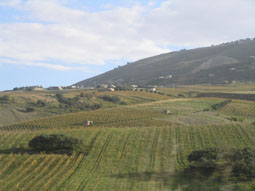 Sicily is the southernmost part of Italy, and is the largest and most populated of the Mediterranean islands with over 25,000 square miles and over 5 million inhabitants, and has the most vineyards of any of the Italian regions.
Sicily is the southernmost part of Italy, and is the largest and most populated of the Mediterranean islands with over 25,000 square miles and over 5 million inhabitants, and has the most vineyards of any of the Italian regions.
The island has 9 provinces: Agrigento, Caltanissetta, Catania, Enna, Messina, Palermo, Ragusa, Siracusa and Trapani. Having traveled extensively throughout Italy, I can truly say that Sicily is unlike any other part of Italy that I have visited. It has a unique feeling all its own, in part due to its diverse history. As a result, the architecture reflects Roman, Byzantine, Arab, Norman, French and Spanish influences, as does the culture and gastronomy, which must be experienced in order to be justly appreciated.
In November 2005, Edward F. Nesta and I flew from Stansted Airport in London direct to Palermo International Airport in Sicily, and were amazed with the diversity of the landscape. When we landed at the airport, there was a dramatic mountain to one side of the runway and the sparkling azure sea on the other. Under the bluest of warm sunny skies, we drove one hour from Palermo, the capital of Sicily, to our hotel, the Kempinski Hotel Giardino di Constanza Resort & Spa in Mazara del Vallo, in the province of Trapani, located in the western part of Sicily. Along the way, we were enthralled with the changing countryside, from the spectacular green mountains, to barren regions, ancient ruins, citrus trees and olive groves, past numerous vineyards, and the mosaic-like tapestry of the farmed landscape in a multitude of shades of green that dotted the landscape. The vegetation is an exotic mix of palm trees, Cyprus trees and cactus, where flowers prevail in a rainbow riot of intense colors.
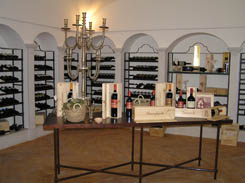 The 91-room hotel Kempinski Hotel Giardino di Constanza Resort & Spa opened in March 2005, and features 13 suites and junior suites, as well as 2 penthouse suites. It is absolutely stunning with an opulent abundance of inlaid marble located throughout the hotel, and features such luxurious appointments as a negative edge pool as well as a family pool outdoors, an indoor pool, a 2,100 square meter Daniela Steiner Beauty Spa, their gourmet Dubbesi Restaurant, Enoteca del Mediterraneo, Fitness Center, Library and Business Center. We thoroughly enjoyed our stay at the hotel and especially the pampering that we received at the Daniela Steiner Beauty Spa which utilizes the best natural Sicilian products in their treatments including Sicilian salt, olive oil and citrus. Executive Chef Salvatore Barbara creates mini-miracles in the Dubbesi kitchen with his creations that are as appealing to the eye as they are to the palate. The professional staff at the hotel goes the extra mile to try to create the perfect experience for every guest. (Read our articles on the hotel in the Hotels & Resorts, Spas, Restaurants and Chefs’ Recipes sections.)
The 91-room hotel Kempinski Hotel Giardino di Constanza Resort & Spa opened in March 2005, and features 13 suites and junior suites, as well as 2 penthouse suites. It is absolutely stunning with an opulent abundance of inlaid marble located throughout the hotel, and features such luxurious appointments as a negative edge pool as well as a family pool outdoors, an indoor pool, a 2,100 square meter Daniela Steiner Beauty Spa, their gourmet Dubbesi Restaurant, Enoteca del Mediterraneo, Fitness Center, Library and Business Center. We thoroughly enjoyed our stay at the hotel and especially the pampering that we received at the Daniela Steiner Beauty Spa which utilizes the best natural Sicilian products in their treatments including Sicilian salt, olive oil and citrus. Executive Chef Salvatore Barbara creates mini-miracles in the Dubbesi kitchen with his creations that are as appealing to the eye as they are to the palate. The professional staff at the hotel goes the extra mile to try to create the perfect experience for every guest. (Read our articles on the hotel in the Hotels & Resorts, Spas, Restaurants and Chefs’ Recipes sections.)
Kempinski Hotel Giardino di Constanza Resort & Spa
Via Salemi Km 7,100
91026 Mazara del Vallo, (TP) Sicily, Italy
Telephone: +39 0923 675 000
Toll free: 00 800 426 313 55
Fax: +39 0923 675876
Email: info.mazara@kempinski.com
Email: Reservations.mazara@kempinski.com
www.kempinski-sicily.com
The Kempinski Hotel Giardino di Constanza Resort & Spa provided the perfect location as our base, as we drove around exploring the western part of Sicily. One of our interesting stops was to the port city of Marsala, which is famous for its saltpans as well as its cantines or wine cellars. In 1773, an enterprising Englishmen by the name of John Woodhouse started producing wine in Marsala. In the 19th century other families including the Florio and Ingham-Whitaker families became involved in winemaking. 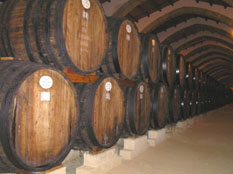 Although we would have enjoyed visiting all of the cantines along the wine trail, as well as the Wine Musuem, due to our tight time schedule, we decided to visit Cantine Florio, one of the more famous of the cantines that was established by Vincenzo Florio in 1833. In 1924, Cinzano bought Florio, and in 1928 they also purchased the Woodhouse and Ingham-Whitaker wineries and combined the three companies into one. After three hours at Cantine Florio for a tour with the enthusiastic and extremely knowledgeable Bruno Parisi, followed by a tasting with Bruno and Vincenzo Massimo, we felt that we had acquired substantial information about the interesting history of Marsala wine, which is a DOC fortified wine. In addition to learning the history of Marsala, we also had the opportunity to taste several of the Florio Marsala wines that are only available in Sicily, which makes a wine trip to Sicily most worthwhile. Marsala is located 31.5 km from the city of Trapani. (Please read our article on Marsala Wine Tasting and the Cantine Florio in our Wine Cellar section.)
Although we would have enjoyed visiting all of the cantines along the wine trail, as well as the Wine Musuem, due to our tight time schedule, we decided to visit Cantine Florio, one of the more famous of the cantines that was established by Vincenzo Florio in 1833. In 1924, Cinzano bought Florio, and in 1928 they also purchased the Woodhouse and Ingham-Whitaker wineries and combined the three companies into one. After three hours at Cantine Florio for a tour with the enthusiastic and extremely knowledgeable Bruno Parisi, followed by a tasting with Bruno and Vincenzo Massimo, we felt that we had acquired substantial information about the interesting history of Marsala wine, which is a DOC fortified wine. In addition to learning the history of Marsala, we also had the opportunity to taste several of the Florio Marsala wines that are only available in Sicily, which makes a wine trip to Sicily most worthwhile. Marsala is located 31.5 km from the city of Trapani. (Please read our article on Marsala Wine Tasting and the Cantine Florio in our Wine Cellar section.)
Cantine Florio
Via Vincezo Florio, I
91025 Marsala, (TP) Sicily, Italy
Telephone: +39 0923 781 111
Fax: + 39 0923 982 380
Email: info@cantineflorio.it
www.cantineflorio.com
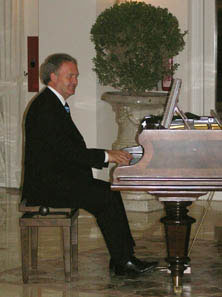 Since we visited Sicily in late autumn, by the time we left Cantine Florio, the sun had already set, and we drove back through the winding countryside to Mazara del Vallo guided by the light of the full moon, and the assistance of several friendly Sicilians who pointed us in the right direction after we had made a few wrong turns. We arrived back at the hotel, changed for dinner, and enjoyed listening to the piano music in the Lobby Lounge, before having a special dinner at Dubbesi Restaurant. (Read our articles on Dubbesi Restaurant in the Restaurant and Chefs’ Recipes sections where Executive Chef Salvatore Barbara shares some of his delicious Sicilian recipes.)
Since we visited Sicily in late autumn, by the time we left Cantine Florio, the sun had already set, and we drove back through the winding countryside to Mazara del Vallo guided by the light of the full moon, and the assistance of several friendly Sicilians who pointed us in the right direction after we had made a few wrong turns. We arrived back at the hotel, changed for dinner, and enjoyed listening to the piano music in the Lobby Lounge, before having a special dinner at Dubbesi Restaurant. (Read our articles on Dubbesi Restaurant in the Restaurant and Chefs’ Recipes sections where Executive Chef Salvatore Barbara shares some of his delicious Sicilian recipes.)
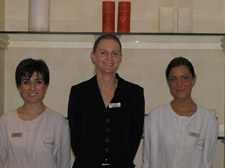 The next morning, we decided that we needed to take time for some pampering, and experienced spa treatments at the Daniela Steiner Beauty Spa. This spa is the epitome of what a luxury spa is all about; opulent tranquil treatment rooms, professional and courteous staff, a wide variety of treatments available, and the best natural products. We indulged in a Sicilian High Salt Energizer treatment, where our skin was exfoliated and energized with Sicilian olive oil and Sicilian salt, followed by a Volcanic Clay treatment, and lastly, Cleopatra’s Bath an indulgent bath in a mixture of milk, olive oil, essential oils and honey. We emerged feeling rested, peaceful and decidedly pampered. (Read our article about the Daniela Steiner Beauty Spa in the Spas section.)
The next morning, we decided that we needed to take time for some pampering, and experienced spa treatments at the Daniela Steiner Beauty Spa. This spa is the epitome of what a luxury spa is all about; opulent tranquil treatment rooms, professional and courteous staff, a wide variety of treatments available, and the best natural products. We indulged in a Sicilian High Salt Energizer treatment, where our skin was exfoliated and energized with Sicilian olive oil and Sicilian salt, followed by a Volcanic Clay treatment, and lastly, Cleopatra’s Bath an indulgent bath in a mixture of milk, olive oil, essential oils and honey. We emerged feeling rested, peaceful and decidedly pampered. (Read our article about the Daniela Steiner Beauty Spa in the Spas section.)
Daniela Steiner Beauty Spa
Kempinski Hotel Giardino di Constanza Resort & Spa
Via Salemi Km 7,100
91026 Mazara del Vallo, (TP) Sicily, Italy
Telephone: +39 0923 675 000
Toll free: 00 800 426 313 55
Fax: +39 0923 675876
Email: daniela.Steiner@kempinksi.com
www.kempinski-sicily.com
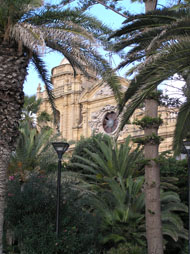 After treating our bodies at the spa, it was time to treat our eyes to more of the beauty of Sicily. We went to the city of Mazara del Vallo, population 51,964, to visit the Museo del Satiro, to see the 4th century bronze statue, Il Satiro Danzante (the Dancing Satyr), attributed to the artist, Prassitele. A fisherman unwittingly discovered a part of the statue in 1997 in the Sicilian Channel while fishing, and the rest of the statue was later found in March of 1998. Although the 3 meters statue is very interesting, the museum consists of only one room, so after we saw Il Satiro Danzante it was time to discover other interesting sites in the city. We arrived at the museum just before 1:00 pm, and when we left a short while later, we found that the shops had already closed. It is important to note that shops in Sicily close for several hours in the afternoon and then reopen later in the evening, so it is best to plan your day accordingly.
After treating our bodies at the spa, it was time to treat our eyes to more of the beauty of Sicily. We went to the city of Mazara del Vallo, population 51,964, to visit the Museo del Satiro, to see the 4th century bronze statue, Il Satiro Danzante (the Dancing Satyr), attributed to the artist, Prassitele. A fisherman unwittingly discovered a part of the statue in 1997 in the Sicilian Channel while fishing, and the rest of the statue was later found in March of 1998. Although the 3 meters statue is very interesting, the museum consists of only one room, so after we saw Il Satiro Danzante it was time to discover other interesting sites in the city. We arrived at the museum just before 1:00 pm, and when we left a short while later, we found that the shops had already closed. It is important to note that shops in Sicily close for several hours in the afternoon and then reopen later in the evening, so it is best to plan your day accordingly.
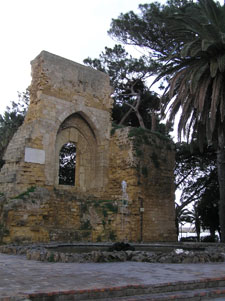 Since the shops were closed, we explored the sights of the city, including the remains of the Norman Arch at Piazza Mokarta, which is the symbol of Mazara del Vallo, the Cattedrale del S.S. Salvatore built in 1093, the Piazza della Repubblica, and the Chiesa do San Michele. We also stopped at Gran Caffè where we savored multiple flavors of delectable gelato. With the shops closed, we decided to leave Mazara del Vallo and drive to Èrice, based on our friend James Waller’s recommendation.
Since the shops were closed, we explored the sights of the city, including the remains of the Norman Arch at Piazza Mokarta, which is the symbol of Mazara del Vallo, the Cattedrale del S.S. Salvatore built in 1093, the Piazza della Repubblica, and the Chiesa do San Michele. We also stopped at Gran Caffè where we savored multiple flavors of delectable gelato. With the shops closed, we decided to leave Mazara del Vallo and drive to Èrice, based on our friend James Waller’s recommendation.
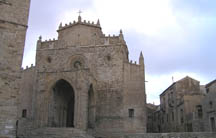 The name Èrice, is derived from the Sican-Sicel-Italic word Eryxx, which means mountain, and has many legends and myths associated with it. It has a population 30,658 and is located 15 km from Trapani, at the summit of Monte San Giuliano, at an altitude of 751 meters. The drive to Èrice is for the intrepid as the road consists of a plethora of hairpin turns, which wind up and around the mountain, until suddenly you are rewarded with the most spectacular views of the sea and the bustling city of Trapani below, that has a population of 69,619. The contrast between the two cities is dramatic not only in population, but with the cobblestone streets of the medieval Èrice, with its narrow winding lanes, and delightful small shops selling ceramics, Sicilian salt, candies, marzipan, Marsala wine and other specialty items and souvenirs.
The name Èrice, is derived from the Sican-Sicel-Italic word Eryxx, which means mountain, and has many legends and myths associated with it. It has a population 30,658 and is located 15 km from Trapani, at the summit of Monte San Giuliano, at an altitude of 751 meters. The drive to Èrice is for the intrepid as the road consists of a plethora of hairpin turns, which wind up and around the mountain, until suddenly you are rewarded with the most spectacular views of the sea and the bustling city of Trapani below, that has a population of 69,619. The contrast between the two cities is dramatic not only in population, but with the cobblestone streets of the medieval Èrice, with its narrow winding lanes, and delightful small shops selling ceramics, Sicilian salt, candies, marzipan, Marsala wine and other specialty items and souvenirs.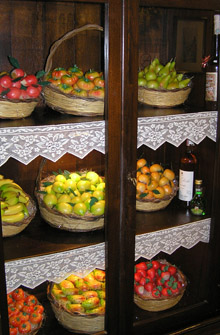 We stopped to eat Sicilian pastries at several of the shops, purchased the famous Sicilian sea salt and other gifts, and also stopped to explore the many churches including the outside of the Chiesa Matrice, dedicated to Our Lady of the Assumption, that was built in 1314 and renovated in 1865, which unfortunately was closed when we arrived. The architecture of Èrice is a mix of Norman, Roman and even Gothic, and the city has an almost surreal feeling to it. Due to the altitude, it can be quite windy, and the day that we were there it was cold and windy, even though it was warm in Trapani. Plan to arrive early in the day to allow enough time to really explore Èrice. We would have spent more time in Èrice, but with darkness approaching, we decided not to linger any longer since the hairpin turns and maze-like narrow winding streets are daunting enough to negotiate during the daylight hours; by moonlight, even with a full moon to guide us, it would have made for a very hair-raising experience.
We stopped to eat Sicilian pastries at several of the shops, purchased the famous Sicilian sea salt and other gifts, and also stopped to explore the many churches including the outside of the Chiesa Matrice, dedicated to Our Lady of the Assumption, that was built in 1314 and renovated in 1865, which unfortunately was closed when we arrived. The architecture of Èrice is a mix of Norman, Roman and even Gothic, and the city has an almost surreal feeling to it. Due to the altitude, it can be quite windy, and the day that we were there it was cold and windy, even though it was warm in Trapani. Plan to arrive early in the day to allow enough time to really explore Èrice. We would have spent more time in Èrice, but with darkness approaching, we decided not to linger any longer since the hairpin turns and maze-like narrow winding streets are daunting enough to negotiate during the daylight hours; by moonlight, even with a full moon to guide us, it would have made for a very hair-raising experience.
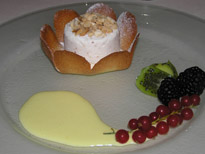 We returned to the hotel, and once again had another remarkable dining experience at the Dubbesi Restaurant. Even though we did our best to try to sample many of the items on the menu, we will need to return to Sicily to fully experience Executive Chef Salvatore Barbara’s creative menu.
We returned to the hotel, and once again had another remarkable dining experience at the Dubbesi Restaurant. Even though we did our best to try to sample many of the items on the menu, we will need to return to Sicily to fully experience Executive Chef Salvatore Barbara’s creative menu.
The next morning, we returned to London, vowing to return to Sicily when we can spend a few weeks exploring the rest of this enchanting island!
Read our other articles on Sicily and the Kempinski Hotel Giardino di Constanza Resort & Spa in our Hotels & Resorts, Spas, Chefs’ Recipes, Restaurants and Wine Cellar sections.
For information on Sicily, Italy, please visit the Italian Government Tourist Board, www.italiantourism.com.
© January 2006. Luxury Experience. www.LuxuryExperience.com. All rights reserved.

